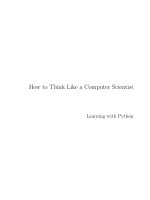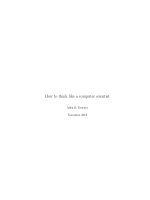Think python how to think like a computer scientist allen b downey
Bạn đang xem bản rút gọn của tài liệu. Xem và tải ngay bản đầy đủ của tài liệu tại đây (3.69 MB, 725 trang )
/>
/>
/>
/>
/>
Think Python
Second Edition
Allen B. Downey
/>
/>
/>
/>
Think Python
by Allen B. Downey
Copyright © 2016 Allen Downey. All rights
reserved. Printed in the United States of
America.
Published by O’Reilly Media, Inc., 1005 Gravenstein Highway North,
Sebastopol, CA 95472.
O’Reilly books may be purchased for educational, business, or sales
promotional use. Online editions are also available for most titles
(). For more information, contact our
corporate/institutional sales department: 800-998-9938 or
Editor: Meghan Blanchette
Production Editor: Kristen Brown
Copyeditor: Nan Reinhardt
Proofreader: Amanda Kersey
Indexer: Allen Downey
Interior Designer: David Futato
Cover Designer: Karen
Montgomery Illustrator: Rebecca
Demarest August 2012: First
Edition December 2015: Second
Edition
/>
/>
Revision History for the Second Edition
2015-11-20: First Release
See for release details.
The O’Reilly logo is a registered trademark of O’Reilly Media, Inc. Think
Python, the cover image of a Carolina parrot, and related trade dress are
trademarks of O’Reilly Media, Inc.
While the publisher and the author have used good faith efforts to ensure that
the information and instructions contained in this work are accurate, the
publisher and the author disclaim all responsibility for errors or omissions,
including without limitation responsibility for damages resulting from the use of or
reliance on this work. Use of the information and instructions contained in this
work is at your own risk. If any code samples or other technology this work
contains or describes is subject to open source licenses or the intellectual
property rights of others, it is your responsibility to ensure that your use thereof
complies with such licenses and/or rights.
Think Python is available under the Creative Commons AttributionNonCommercial 3.0 Unported License. The author maintains an online version
at />978-1-491-939369 [LSI]
/>
/>
/>
/>
Preface
/>
/>
The Strange History of This Book
In January 1999 I was preparing to teach an introductory programming class in
Java. I had taught it three times and I was getting frustrated. The failure rate in
the class was too high and, even for students who succeeded, the overall level
of achievement was too low.
One of the problems I saw was the books. They were too big, with too much
unnecessary detail about Java, and not enough high-level guidance about how to
program. And they all suffered from the trapdoor effect: they would start out easy,
proceed gradually, and then somewhere around Chapter 5 the bottom would fall
out. The students would get too much new material, too fast, and I would spend
the rest of the semester picking up the pieces.
Two weeks before the first day of classes, I decided to write my own book. My
goals were:
Keep it short. It is better for students to read 10 pages than not read 50 pages.
Be careful with vocabulary. I tried to minimize jargon and define each term at
first use.
Build gradually. To avoid trapdoors, I took the most difficult topics and split
them into a series of small steps.
Focus on programming, not the programming language. I included the
minimum useful subset of Java and left out the rest.
I needed a title, so on a whim I chose How to Think Like a Computer Scientist.
My first version was rough, but it worked. Students did the reading, and they
understood enough that I could spend class time on the hard topics, the
interesting topics and (most important) letting the students practice.
I released the book under the GNU Free Documentation License, which allows
users to copy, modify, and distribute the book.
What happened next is the cool part. Jeff Elkner, a high school teacher in
Virginia, adopted my book and translated it into Python. He sent me a copy of his
translation, and I had the unusual experience of learning Python by reading my
own book. As Green Tea Press, I published the first Python version in 2001.
In 2003 I started teaching at Olin College and I got to teach Python for the first
time. The contrast with Java was striking. Students struggled less, learned more,
worked on more interesting projects, and generally had a lot more fun.
/>
/>
Since then I’ve continued to develop the book, correcting errors, improving
some of the examples and adding material, especially exercises.
The result is this book, now with the less grandiose title Think Python.
Some of the changes are:
I added a section about debugging at the end of each chapter. These sections
present
/>
/>
general techniques for finding and avoiding bugs, and warnings about Python
pitfalls.
I added more exercises, ranging from short tests of understanding to a few
substantial projects. Most exercises include a link to my solution.
I added a series of case studies — longer examples with exercises,
solutions, and discussion.
I expanded the discussion of program development plans and basic design
patterns. I added appendices about debugging and analysis of algorithms.
The second edition of Think Python has these new features:
The book and all supporting code have been updated to Python 3.
I added a few sections, and more details on the Web, to help beginners get
started running Python in a browser, so you don’t have to deal with installing
Python until you want to.
For “The turtle Module” I switched from my own turtle graphics package,
called Swampy, to a more standard Python module, turtle, which is easier
to install and more powerful.
I added a new chapter called “The Goodies”, which introduces some
additional Python features that are not strictly necessary, but sometimes
handy.
I hope you enjoy working with this book, and that it helps you learn to program
and think like a computer scientist, at least a little bit.
— Allen B. Downey
Olin College
/>
/>
Conventions Used in This Book
The following typographical conventions are used in this book:
Italic
Indicates new terms, URLs, email addresses, filenames, and file extensions.
Bold
Indicates terms defined in the Glossary.
Constant width
Used for program listings, as well as within paragraphs to refer to program
elements such as variable or function names, databases, data types,
environment variables, statements, and keywords.
Constant width bold
Shows commands or other text that should be typed literally by the user.
Constant width italic
Shows text that should be replaced with user-supplied values or by values
determined by context.
/>
/>
Using Code Examples
Supplemental material (code examples, exercises, etc.) is available for download
at
/>This book is here to help you get your job done. In general, if example code is
offered with this book, you may use it in your programs and documentation. You
do not need to contact us for permission unless you’re reproducing a significant
portion of the code. For example, writing a program that uses several chunks of
code from this book does not require permission. Selling or distributing a CDROM of examples from O’Reilly books does require permission. Answering a
question by citing this book and quoting example code does not require
permission. Incorporating a significant amount of example code from this book
into your product’s documentation does require permission.
We appreciate, but do not require, attribution. An attribution usually includes the
title, author, publisher, and ISBN. For example: “Think Python, 2nd Edition, by
Allen B. Downey (O’Reilly). Copyright 2016 Allen Downey, 978-1-4919-3936-9.”
If you feel your use of code examples falls outside fair use or the permission
given above, feel free to contact us at
/>
/>
Safari® Books Online
Safari Books Online (www.safaribooksonline.com) is an on-demand digital library
that delivers expert content in both book and video form from the world’s leading
authors in technology and business.
Technology professionals, software developers, web designers, and business
and creative professionals use Safari Books Online as their primary resource for
research, problem solving, learning, and certification training.
Safari Books Online offers a range of plans and pricing for enterprise,
government, and education, and individuals.
Members have access to thousands of books, training videos, and prepublication
manuscripts in one fully searchable database from publishers like O’Reilly Media,
Prentice Hall Professional, Addison-Wesley Professional, Microsoft Press, Sams,
Que, Peachpit Press, Focal Press, Cisco Press, John Wiley & Sons, Syngress,
Morgan Kaufmann, IBM Redbooks, Packt, Adobe Press, FT Press, Apress,
Manning, New Riders, McGraw-Hill, Jones & Bartlett, Course Technology, and
hundreds more. For more information about Safari Books Online, please visit us
online.
/>
/>
How to Contact Us
Please address comments and questions concerning this book to the
publisher: O’Reilly Media, Inc.
1005 Gravenstein Highway
North Sebastopol, CA 95472
800-998-9938 (in the United States or
Canada) 707-829-0515 (international or
local)
707-829-0104 (fax)
We have a web page for this book, where we list errata, examples, and any
additional information. You can access this page at />To comment or ask technical questions about this book, send email to
For more information about our books, courses, conferences, and news, see our
website at
.
Find us on Facebook: />Follow us on Twitter: />Watch us on YouTube: />
/>
/>
Acknowledgments
Many thanks to Jeff Elkner, who translated my Java book into Python, which got
this project started and introduced me to what has turned out to be my favorite
language.
Thanks also to Chris Meyers, who contributed several sections to How to
Think Like a Computer Scientist.
Thanks to the Free Software Foundation for developing the GNU Free
Documentation License, which helped make my collaboration with Jeff and
Chris possible, and Creative Commons for the license I am using now.
Thanks to the editors at Lulu who worked on How to Think Like a Computer
Scientist. Thanks to the editors at O’Reilly Media who worked on Think
Python.
Thanks to all the students who worked with earlier versions of this book
and all the contributors (listed below) who sent in corrections and
suggestions.
/>
/>
Contributor List
More than 100 sharp-eyed and thoughtful readers have sent in suggestions and
corrections over the past few years. Their contributions, and enthusiasm for this
project, have been a huge help.
If you have a suggestion or correction, please send email to
If I make a change based on your feedback, I will
add you to the contributor list (unless you ask to be omitted).
If you include at least part of the sentence the error appears in, that makes it easy
for me to search. Page and section numbers are fine, too, but not quite as easy to
work with. Thanks!
Lloyd Hugh Allen sent in a correction to Section 8.4.
Yvon Boulianne sent in a correction of a semantic error in
Chapter 5. Fred Bremmer submitted a correction in Section
2.1.
Jonah Cohen wrote the Perl scripts to convert the LaTeX source for this book
into beautiful HTML.
Michael Conlon sent in a grammar correction in Chapter 2 and an
improvement in style in Chapter 1, and he initiated discussion on the technical
aspects of interpreters.
Benoit Girard sent in a correction to a humorous mistake in Section 5.6.
Courtney Gleason and Katherine Smith wrote horsebet.py, which was used as a
case study in an earlier version of the book. Their program can now be found
on the website.
Lee Harr submitted more corrections than we have room to list here, and
indeed he should be listed as one of the principal editors of the text.
James Kaylin is a student using the text. He has submitted numerous
corrections. David Kershaw fixed the broken catTwice function in Section
3.10.
Eddie Lam has sent in numerous corrections to Chapters 1, 2, and 3. He also
fixed the Makefile so that it creates an index the first time it is run and helped
us set up a versioning scheme.
/>
/>
Man-Yong Lee sent in a correction to the example code in Section 2.4.
David Mayo pointed out that the word “unconsciously” in Chapter 1
needed to be changed to “subconsciously”.
Chris McAloon sent in several corrections to Sections 3.9 and 3.10.
/>
/>
Matthew J. Moelter has been a long-time contributor who sent in numerous
corrections and suggestions to the book.
Simon Dicon Montford reported a missing function definition and several
typos in Chapter 3. He also found errors in the increment function in Chapter
13.
John Ouzts corrected the definition of “return value” in Chapter 3.
Kevin Parks sent in valuable comments and suggestions as to how to
improve the distribution of the book.
David Pool sent in a typo in the glossary of Chapter 1, as well as kind
words of encouragement.
Michael Schmitt sent in a correction to the chapter on files and exceptions.
Robin Shaw pointed out an error in Section 13.1, where the printTime function
was used in an example without being defined.
Paul Sleigh found an error in Chapter 7 and a bug in Jonah Cohen’s Perl script
that generates HTML from LaTeX.
Craig T. Snydal is testing the text in a course at Drew University. He has
contributed several valuable suggestions and corrections.
Ian Thomas and his students are using the text in a programming course.
They are the first ones to test the chapters in the latter half of the book, and
they have made numerous corrections and suggestions.
Keith Verheyden sent in a correction in Chapter 3.
Peter Winstanley let us know about a longstanding error in our Latin in
Chapter 3. Chris Wrobel made corrections to the code in the chapter on file I/
O and exceptions.
Moshe Zadka has made invaluable contributions to this project. In addition to
writing the first draft of the chapter on Dictionaries, he provided continual
guidance in the early stages of the book.
Christoph Zwerschke sent several corrections and pedagogic
suggestions, and explained the difference between gleich and selbe.
James Mayer sent us a whole slew of spelling and typographical errors,
including two in the contributor list.
/>
/>
Hayden McAfee caught a potentially confusing inconsistency between two
examples. Angel Arnal is part of an international team of translators working
on the Spanish
/>









